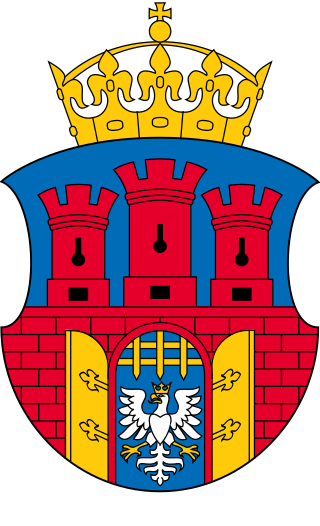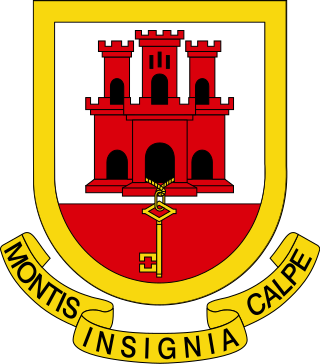
Heraldry is a discipline relating to the design, display and study of armorial bearings, as well as related disciplines, such as vexillology, together with the study of ceremony, rank and pedigree. Armory, the best-known branch of heraldry, concerns the design and transmission of the heraldic achievement. The achievement, or armorial bearings usually includes a coat of arms on a shield, helmet and crest, together with any accompanying devices, such as supporters, badges, heraldic banners and mottoes.

In heraldry, an ordinary is one of the two main types of charges, beside the mobile charges. An ordinary is a simple geometrical figure, bounded by straight lines and running from side to side or top to bottom of the shield. There are also some geometric charges known as subordinaries, which have been given lesser status by some heraldic writers, though most have been in use as long as the traditional ordinaries. Diminutives of ordinaries and some subordinaries are charges of the same shape, though thinner. Most of the ordinaries are theoretically said to occupy one-third of the shield; but this is rarely observed in practice, except when the ordinary is the only charge.

In heraldry, an escutcheon is a shield that forms the main or focal element in an achievement of arms. The word can be used in two related senses. In the first sense, an escutcheon is the shield upon which a coat of arms is displayed. In the second sense, an escutcheon can itself be a charge within a coat of arms.

The city of Kraków uses a coat of arms, a seal, official colors, a flag, and a banner as its official symbols. Additionally, a number of semi-official and unofficial symbols of the city are also used.

The Columns of Gediminas or Pillars of Gediminas are one of the earliest symbols of Lithuania and its historical coats of arms. They were used in the Grand Duchy of Lithuania, initially as a rulers' personal insignia, a state symbol, and later as a part of heraldic signs of leading aristocracy.

The coat of arms of Belgrade is the official symbol of the City of Belgrade and is stable in three levels - as Basic or Small, Medium and Large.
The flag and the coat of arms of Perlis are state symbols of Perlis, a state in Malaysia. centering on Perlis' monarch and agricultural activities, its flag and arms are similar in symbolisation as the state symbols of Kedah, which it neighbours.

A Royal Badge for Wales was approved in May 2008. It is based on the arms borne by the thirteenth-century Welsh prince Llywelyn the Great, with the addition of St Edward's Crown atop a continuous scroll which, together with a wreath consisting of the plant emblems of the four countries of the United Kingdom, surrounds the shield. The motto which appears on the scroll, PLEIDIOL WYF I'M GWLAD, is taken from the National Anthem of Wales and is also found on the Welsh designs for £1 coins minted from 1985 until 2000. The badge formerly appeared on the covers of Assembly Measures; since the 2011 referendum, it now appears on the cover of Acts passed by the Senedd and its escutcheon, ribbon and motto are depicted on the Welsh Seal.

The coat of arms of Gabon was designed by the Swiss heraldist and vexillologist Louis Mühlemann, one of the founding members of the FIAV and the designer of the coat of arms of the Republic of Congo. It has been in use since 15 July 1963.

The coat of arms of Portugal is the main heraldic insignia of Portugal. The present model was officially adopted on 30 June 1911, along with the present model of the Flag of Portugal. It is based on the coat of arms used by the Kingdom of Portugal since the Middle Ages. The coat of arms of Portugal is popularly referred as the Quinas.

The coat of arms of Fiji is the heraldic device consisting of a shield divided quarterly by Cross of St. George and charged with a gold lion at the top, supported by two Fijian warriors, one on each side, and topped with a canoe as the crest. Adopted in 1908 by a Royal Warrant, it has been the coat of arms of Fiji since that year, having been retained after independence in 1970. The escutcheon from the arms is featured on the flag of Fiji.

The coat of arms of Gibraltar was first granted by a Royal Warrant passed in Toledo on 10 July 1502 by Isabella I of Castile during Gibraltar's Spanish period. The arms consists of an escutcheon and features a three-towered red castle under which hangs a golden key.

Portuguese heraldry encompasses the modern and historic traditions of heraldry in Portugal and the Portuguese Empire. Portuguese heraldry is part of the larger Iberian tradition of heraldry, one of the major schools of heraldic tradition, and grants coats of arms to individuals, cities, Portuguese colonies, and other institutions. Heraldry has been practiced in Portugal at least since the 12th century, however it only became standardized and popularized in the 16th century, during the reign of King Manuel I of Portugal, who created the first heraldic ordinances in the country. Like in other Iberian heraldic traditions, the use of quartering and augmentations of honor is highly representative of Portuguese heraldry, but unlike in any other Iberian traditions, the use of heraldic crests is highly popular.

The coat of arms of Perth, Western Australia were originally granted to the City of Perth on 2 December 1926. They were altered with the slight addition of part of the arms of Perth, Scotland in 1949.

In heraldry and heraldic vexillology, a blazon is a formal description of a coat of arms, flag or similar emblem, from which the reader can reconstruct the appropriate image. The verb to blazon means to create such a description. The visual depiction of a coat of arms or flag has traditionally had considerable latitude in design, but a verbal blazon specifies the essentially distinctive elements. A coat of arms or flag is therefore primarily defined not by a picture but rather by the wording of its blazon. Blazon is also the specialized language in which a blazon is written, and, as a verb, the act of writing such a description. Blazonry is the art, craft or practice of creating a blazon. The language employed in blazonry has its own vocabulary, grammar and syntax, which becomes essential for comprehension when blazoning a complex coat of arms.

The coat of arms of Kropyvnytskyi is one of the city's symbols reflecting its past and the controversies of its history.

The coat of arms of Amsterdam is the official coat of arms symbol of the city of Amsterdam. It consists of a red shield and a black pale with three silver Saint Andrew's Crosses, the Imperial Crown of Austria, two golden lions, and the motto of Amsterdam. Several heraldic elements have their basis in the history of Amsterdam. The crosses and the crown can be found as decorations on different locations in the city.

The flag of Sint Maarten consists of a white triangle situated at the hoist charged with the constituent country's coat of arms, along with two horizontal bands of red and blue. Adopted in 1985 shortly after the territory was granted a coat of arms, it has been the flag of Sint Maarten since 13 June of that year. Since the dissolution of the Netherlands Antilles on 10 October 2010, it has been the sole flag used in the constituent country.
A national coat of arms is a symbol which denotes an independent state in the form of a heraldic achievement. While a national flag is usually used by the population at large and is flown outside and on ships, a national coat of arms is normally considered a symbol of the government or the head of state personally and tends to be used in print, on armorial ware, and as a wall decoration in official buildings. The royal arms of a monarchy, which may be identical to the national arms, are sometimes described as arms of dominion or arms of sovereignty.

The coat of arms of Donetsk is an official symbol of the city of Donetsk. It depicts a golden hand holding a hammer, alongside a golden five-pointed star to its right. The current version of the coat of arms was adopted on 5 July 1995. The predecessor to the modern-day coat of arms was used in the Ukrainian SSR, dating back to 1968.
















